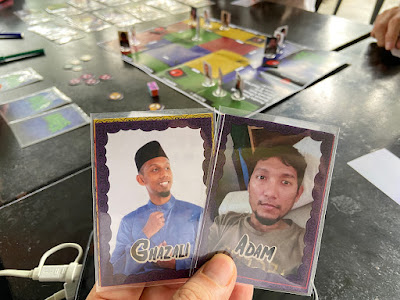My first physically published game (self-published), Dancing Queen, was
released at the end of 2022. Publishing my own game was kind of a bucket list
thing. My motivation for creating games is to bring joy to people. I want to
bring something fresh and different to players. I want to create happy moments
and novel experiences. Self-publishing a game in itself is not exactly an
achievement. Anyone with some spare cash can do it. Anyone can be a game
designer. If by publishing my game I am only giving myself self-satisfaction,
and not many people actually buy or play my game, and I end up with many
unwanted copies at home, then I'm just wasting time, money and resources. For
the sake of stroking my ego. I don't want to be doing this, so when I
contemplated getting into game design and publishing, I thought hard and deep
about how should I be doing all this.
For many years I have been just a consumer in the boardgame hobby. I was a
user. I was not in the industry. I knew if I wanted to get into the industry,
it wouldn't be simple. Making game design or game publishing a livelihood is
not easy. They say making a small fortune from boardgames is easy - when you
start with a big fortune. It is perfectly fine to enjoy the hobby as a
consumer. Why go into designing and publishing? Why am I trying to turn a
not-too-costly hobby into an expensive one? Game designing and publishing is a
business. It should not be an expensive hobby. I told myself if I wanted to go
into this, it cannot be just burning money. Bringing joy to people is noble,
but if I'm burning money to do this, I'm doing it wrong.
Now my plan is for five years I want to be releasing one game per year. I
don't expect to make much money, but I want to make sure I'm not throwing
money into a bottomless pit. I want to see some results, so that I can prove
to myself that I am capable of doing this. If I'm not as good as I think, I
should go back to just being a consumer. That's not a problem.
Now I have set up Cili Padi Games and published Dancing Queen. It is getting good praise. It
achieved targets I set for myself (admittedly not very high targets). So now I
am allowing myself to move on to the next game project. I want to do a game a
year because I need to improve by doing. My next project will be
Snow White and the Eleven Dwarfs.
The artwork I use for my prototype is all from the internet. I don't have any
of the copyrights. I will need to look for a professional artist to do my own
art. I quite like the style of these dwarfs. I'm asking Edwin (who did
Dancing Queen) to help me with my next project.
Dancing Queen is a rather niche game. It is a filler for gamers, which
is already an oxymoron. Economically, publishing and marketing the game is
challenging. If I want to sell more copies of my game, I probably should make
something which appeals to a wider audience. Dancing Queen is not
easy for casual players to learn by themselves. Seasoned gamers will
appreciate the nuances, but a clever filler is not something they plan gaming
sessions around.
Snow White is a very different beast from Dancing Queen. It is
not a strictly 2-player game. Instead, its minimum player count is 7. It works
well for casual players, but it is still a niche game, because of this unusual
player count. Most game publishers don't want to publish this kind of game.
They prefer games which support 2 to 5 players. Minimum 7 makes a game harder
to bring to the table. Sometimes I wonder why I am punishing myself like this.
My game publishing choices are making life difficult for myself.
I have playtested Snow White many times, and I am surprised at how
well received it is. Recently I-van Yee did an event at Invictus Forge,
inviting his students to experience locally designed games. I brought some of
my prototypes. It was a good opportunity for playtesting.
I had a few variants which I had not been able to test, because it was
difficult to arrange such a large group of players. Finally I was now able to
test the Evil Queen variant. In the basic game, there are two factions, Snow
White being one, and the dwarfs the other. When the Queen is introduced, she
becomes the new third faction. In the basic game, Snow White wins by guessing
the #1 dwarf correctly. If she guesses wrong, the dwarfs win. The dwarfs win
by guessing the number of the dwarf who overslept. If they guess wrong, Snow
White wins. There is always only one chance for anyone to make a guess,
because the outcome of the guess determines who wins, and the game ends.
When the Queen is introduced, she stays hidden among the dwarfs to sow
confusion. She wins when Snow White or the dwarfs make a wrong guess. Snow
White and the dwarfs can only win by making correct guesses. If the other
party makes a wrong guess, it is the Queen who wins instead.
I was worried whether the Queen mechanism would make the game too difficult
for Snow White and the dwarfs. Without lies and a secret saboteur, the game is
already challenging. There is a lot of information to process. Add on some
pieces of data which might be false, all the deductions and calculations can
be totally thrown off. As I watched the students play, I had a nagging feeling
I was right to worry. Surprisingly, the dwarfs made a correct guess and won. One dwarf
loudly declared that this missing dwarf must be a 5 or a 7. Another said it
couldn't be a 5. Yet another said she was positive it was a 2. She was adamant
so the rest decided to let her take the guess. I had thought she would be
wrong because she was the only one thinking it was a 2. She turned out to be
right. They all cheered happily. It was a wonderful feeling seeing people enjoy
my game.
Many players used their phones to take notes when playing
Snow White.
This is another design of mine - Romeo & Juliet. This is a secret
identity team game. Team Romance wants to bring Romeo and Juliet together.
Team Duty wants to break them up and force Juliet to marry Count Paris. After
the game one of the young gentlemen came up to me to say he really liked the
game. That was a touching moment.
Thank you boys and girls for playing my games.
27 May 2023, Jon organised a TTGDMY playtesting session in Kajang. I finally
managed to playtest Chee Kong's game In a Blissful World. He has spent
a lot of time and energy on this design. The vision he has in mind is a deck of cards with which you
can play many different games. In a Blissful World is just one of the
games. The card deck itself is called Zodiac Go. When working on the
game, Chee Kong had asked me for feedback on the art, so I had seen the game
before. Although this was my first time playing the game, it already felt
somewhat familiar.
The cards have three characteristics. Firstly, they are numbered 1 to 12, each
represented by one of the Chinese Zodiac signs. There are also in one of five
elements - metal, wood, water, fire, earth. Finally they come in two
polarities, yin and yang. I have seen the art before on my phone. Now that I
get to see the physical cards, I find they look better in person.
There is no cat in the Chinese Zodiac. In this game the cats are jokers.
You don't directly draw cards from the decks. You pick from the 16 cards in
the market.
The game is like rummy. You play melds. There are three types of
melds, the straights, the same kinds and the yin-yang pairs. This meld on the
left is a yin-yang pair - metal (yellow) mouse but one yin (black background)
and one yang (white background).
This is Haireey's latest game, Waris Nenek (Grandma's heir). Grandma is
dying and all the relatives are assembled at the old house hoping to get some
inheritance. Most of these family members are possessed by demons. Most
players play these demons, and one player plays the bomoh (witch doctor), who
tries to protect the true heir. The demons need to find the true heir within
10 rounds. The first demon to do so wins. However if you guess wrong, you
are out of the game. The bomoh needs to keep the true heir safe until the end
of Round 10 to win.
These are the 12 characters in the game. The demons may question the bomoh
about characteristics of the heir. The bomoh may lie. The demons individually
need to work out which answers are lies and which are truths. They rely on
these answers to work out who the heir is.
Demons have some character cards in hand. They help eliminate the possibilities.
The character card of the heir is in the hands of the bomoh.
This is Jon's game, Inspector's Choice. Every player has a score card, money, and two tokens - jail and release.
When the game starts you draw a secret mission telling you the kind of feature you are supporting. In my case I drew glasses. Every time a suspect wearing glasses is freed, I earn one point. However if a suspect wearing glasses is jailed I lose a point.
On the left there is one very specific person shown. If this specific person is freed, I earn 5 points.
Every turn one person will play the inspector, and the others will try to bribe him. Five suspects are put in a line-up. The inspector will announce who he intends to jail (red token) and who to free (green). This is just the initial intention and it is not the final decision. All other players may now openly bribe the inspector, trying to influence his decision to jail or to free someone else. After all the bribes are offered, the inspector makes the final decisions.
This is a game in which you need to guess your opponents' secret mission, in order to be able to effectively minimise helping them score points and also to force them to lose points. I found this quite interesting.
This is Yi Jian's micro RPG, My Dishonourable Brother, inspired by the Lee Kwan Yew family saga in Singapore. In this game, the elderly father has just passed away, and the siblings find out that many of the properties left behind have not be managed well. They start accusing one another of mishandling. This is a game where you can be creative and exercise your eloquence.
All the best to Malaysian game designers!
















No comments:
Post a Comment